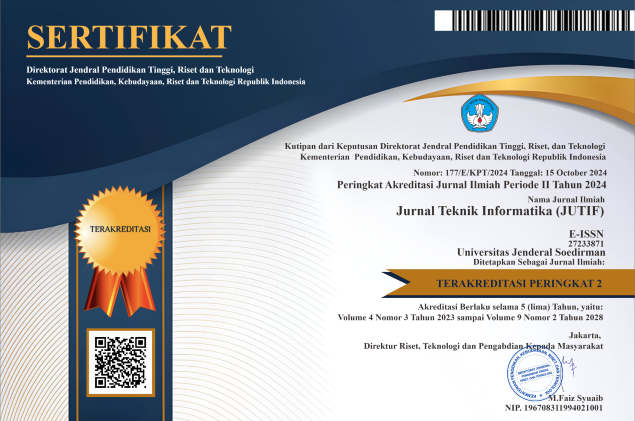Palm Oil Seed Origin Classification Based on Thermal Images and Agricultural Data Using Convolutional Neural Network
DOI:
https://doi.org/10.52436/1.jutif.2025.6.4.4880Keywords:
Agricultural Data, Convolutional Neural Network, Multimodal Deep Learning, Palm Oil Seed Origin, Thermal Image ClassificationAbstract
The traceability of palm oil seed origins plays a vital role in ensuring transparency, legality, and sustainability across the palm oil supply chain. Recent advances in deep learning have created new opportunities to improve classification systems by leveraging both visual and contextual data. This study proposes a deep learning-based model for classifying the origin of palm oil seeds by integrating thermal imagery with agricultural data. Two convolutional neural network (CNN) architectures, ResNet50 and MobileNet, were evaluated under three experimental setups: using only thermal images, combining thermal images with agricultural features (socio-economic, soil, and spectral fruit characteristics), and applying hyperparameter tuning to the best-performing model. The results show that ResNet50 consistently outperformed MobileNet, particularly in multimodal configurations. The highest performance was achieved using ResNet50 with the Adam optimizer, a learning rate of 0.001, and a batch size of 16, resulting in training accuracy of 99.75%, validation accuracy of 99.92%, and test accuracy of 100.00%. Evaluation metrics confirmed the model’s robustness with precision, recall, and F1-score all reaching 100.00%. This research highlights the significant potential of combining thermal imagery and agricultural data in CNN-based models for accurate and reliable classification of palm oil seed origins. The approach can support traceability systems in the palm oil industry, offering a scalable and data-driven solution for ensuring supply chain integrity and sustainability.
Downloads
References
F. Baa Adade, “Oil Palm (Elaeis guineensis) Cultivation and Food Security in the Tropical World,” in Elaeis guineensis, H. Kamyab, Ed., Rijeka: IntechOpen, 2022, pp. 1–5. doi: 10.5772/intechopen.98486.
Badan Pusat Statistik, “Statistik Kelapa Sawit Indonesia 2023,” Badan Pusat Statistik. Accessed: Jan. 17, 2025. [Online]. Available: https://www.bps.go.id/id/publication/2024/11/29/d5dcb42ab730df1be4339c34/statistik-kelapa-sawit-indonesia-2023.html
N. L. Rozali et al., “Omics Technologies: A Strategy to Expedite the Geographical Traceability and Authenticity of Palm Oil,” Food Bioproc Tech, vol. 18, no. 5, pp. 4101–4128, May 2025, doi: 10.1007/s11947-024-03673-w.
U. S. Ramli et al., “Sustainable Palm Oil—The Role of Screening and Advanced Analytical Techniques for Geographical Traceability and Authenticity Verification,” Molecules, vol. 25, no. 12, p. 2927, Jun. 2020, doi: 10.3390/molecules25122927.
L. Cheng-Li Ooi et al., “Improving oil palm sustainability with molecular-precision agriculture: yield impact of SHELL DNA testing in the Malaysian oil palm supply chain,” Sci Hortic, vol. 321, p. 112305, Nov. 2023, doi: 10.1016/j.scienta.2023.112305.
X. Li, J. Du, W. Li, and F. Shahzad, “Green ambitions: A comprehensive model for enhanced traceability in agricultural product supply chain to ensure quality and safety,” J Clean Prod, vol. 420, p. 138397, Sep. 2023, doi: 10.1016/j.jclepro.2023.138397.
D. Shao and N. Marwa, “Blockchain-enabled smart contracts for enhancing seed certification transparency: A design science approach,” Smart Agricultural Technology, vol. 9, p. 100651, Dec. 2024, doi: 10.1016/j.atech.2024.100651.
H. R. Hasan et al., “Smart agriculture assurance: IoT and blockchain for trusted sustainable produce,” Comput Electron Agric, vol. 224, p. 109184, Sep. 2024, doi: 10.1016/j.compag.2024.109184.
A. Y. Khaled, C. A. Parrish, and A. Adedeji, “Emerging nondestructive approaches for meat quality and safety evaluation—A review,” Compr Rev Food Sci Food Saf, vol. 20, no. 4, pp. 3438–3463, Jul. 2021, doi: 10.1111/1541-4337.12781.
Y. Gao, H. Wang, M. Li, and W.-H. Su, “Automatic Tandem Dual BlendMask Networks for Severity Assessment of Wheat Fusarium Head Blight,” Agriculture, vol. 12, no. 9, p. 1493, Sep. 2022, doi: 10.3390/agriculture12091493.
G. Choudhary and D. Sethi, “From Conventional Approach to Machine Learning and Deep Learning Approach: An Experimental and Comprehensive Review of Image Fusion Techniques,” Archives of Computational Methods in Engineering, vol. 30, no. 2, pp. 1267–1304, Mar. 2023, doi: 10.1007/s11831-022-09833-5.
J. A. Wani, S. Sharma, M. Muzamil, S. Ahmed, S. Sharma, and S. Singh, “Machine Learning and Deep Learning Based Computational Techniques in Automatic Agricultural Diseases Detection: Methodologies, Applications, and Challenges,” Archives of Computational Methods in Engineering, vol. 29, no. 1, pp. 641–677, Jan. 2022, doi: 10.1007/s11831-021-09588-5.
Z. H. Arif et al., “Comprehensive Review of Machine Learning (ML) in Image Defogging: Taxonomy of Concepts, Scenes, Feature Extraction, and Classification techniques,” IET Image Process, vol. 16, no. 2, pp. 289–310, Feb. 2022, doi: 10.1049/ipr2.12365.
S. Zolfagharnassab, A. R. B. M. Shariff, R. Ehsani, H. Z. Jaafar, and I. Bin Aris, “Classification of Oil Palm Fresh Fruit Bunches Based on Their Maturity Using Thermal Imaging Technique,” Agriculture, vol. 12, no. 11, p. 1779, Oct. 2022, doi: 10.3390/agriculture12111779.
R. Adhitama Putra Hernanda, H. Lee, J. Cho, G. Kim, B.-K. Cho, and M. S. Kim, “Current trends in the use of thermal imagery in assessing plant stresses: A review,” Comput Electron Agric, vol. 224, p. 109227, Sep. 2024, doi: 10.1016/j.compag.2024.109227.
T. Wen, J.-H. Li, Q. Wang, Y.-Y. Gao, G.-F. Hao, and B.-A. Song, “Thermal imaging: The digital eye facilitates high-throughput phenotyping traits of plant growth and stress responses,” Science of The Total Environment, vol. 899, p. 165626, Nov. 2023, doi: 10.1016/j.scitotenv.2023.165626.
S. E. Widodo, S. Waluyo, Zulferiyenni, and R. Latansya, “Detection of fruit maturity of ‘Cavendish’ banana using thermal image processing,” 2023, p. 050003. doi: 10.1063/5.0135795.
R. R. Patil and S. Kumar, “Rice-Fusion: A Multimodality Data Fusion Framework for Rice Disease Diagnosis,” IEEE Access, vol. 10, pp. 5207–5222, 2022, doi: 10.1109/ACCESS.2022.3140815.
P. Nagpal, S. A. Bhinge, and A. Shitole, “A Comparative Analysis of ResNet Architectures,” in 2022 International Conference on Smart Generation Computing, Communication and Networking (SMART GENCON), IEEE, Dec. 2022, pp. 1–8. doi: 10.1109/SMARTGENCON56628.2022.10083966.
L. Borawar and R. Kaur, “ResNet: Solving Vanishing Gradient in Deep Networks,” 2023, pp. 235–247. doi: 10.1007/978-981-19-8825-7_21.
B. Li, “Lightweight Neural Networks,” in Embedded Artificial Intelligence, Singapore: Springer Nature Singapore, 2024, pp. 43–74. doi: 10.1007/978-981-97-5038-2_3.
S.-F. Hsiao and B.-C. Tsai, “Efficient Computation of Depthwise Separable Convolution in MoblieNet Deep Neural Network Models,” in 2021 IEEE International Conference on Consumer Electronics-Taiwan (ICCE-TW), IEEE, Sep. 2021, pp. 1–2. doi: 10.1109/ICCE-TW52618.2021.9602973.
E. Prasiwiningrum and A. Lubis, “Classification Of Palm Oil Maturity Using CNN (Convolution Neural Network) Modelling RestNet 50,” Decode, vol. 4, no. 3, pp. 983–999, 2024, doi: 10.51454/decode.v4i3.822.
Venkatesh, N. Y, S. U. Hegde, and S. S, “Fine-tuned MobileNet Classifier for Classification of Strawberry and Cherry Fruit Types,” in 2021 International Conference on Computer Communication and Informatics (ICCCI), IEEE, Jan. 2021, pp. 1–8. doi: 10.1109/ICCCI50826.2021.9402444.
M. S. A. M. Al‐gaashani, F. Shang, M. S. A. Muthanna, M. Khayyat, and A. A. Abd El‐Latif, “Tomato leaf disease classification by exploiting transfer learning and feature concatenation,” IET Image Process, vol. 16, no. 3, pp. 913–925, Feb. 2022, doi: 10.1049/ipr2.12397.
M. Bilal, G. Ali, M. W. Iqbal, M. Anwar, M. S. A. Malik, and R. A. Kadir, “Auto-Prep: Efficient and Automated Data Preprocessing Pipeline,” IEEE Access, vol. 10, pp. 107764–107784, 2022, doi: 10.1109/ACCESS.2022.3198662.
K. Rahul, R. K. Banyal, and N. Arora, “A systematic review on big data applications and scope for industrial processing and healthcare sectors,” J Big Data, vol. 10, no. 1, p. 133, Aug. 2023, doi: 10.1186/s40537-023-00808-2.
K. Maharana, S. Mondal, and B. Nemade, “A review: Data pre-processing and data augmentation techniques,” Global Transitions Proceedings, vol. 3, no. 1, pp. 91–99, Jun. 2022, doi: 10.1016/j.gltp.2022.04.020.
C. Li, X. Ren, and G. Zhao, “Machine-Learning-Based Imputation Method for Filling Missing Values in Ground Meteorological Observation Data,” Algorithms, vol. 16, no. 9, p. 422, Sep. 2023, doi: 10.3390/a16090422.
L. Wang, S. Jiang, and S. Jiang, “A feature selection method via analysis of relevance, redundancy, and interaction,” Expert Syst Appl, vol. 183, p. 115365, Nov. 2021, doi: 10.1016/j.eswa.2021.115365.
D. Effrosynidis and A. Arampatzis, “An evaluation of feature selection methods for environmental data,” Ecol Inform, vol. 61, p. 101224, Mar. 2021, doi: 10.1016/j.ecoinf.2021.101224.
H. A. Alenizy and J. Berri, “Transforming tabular data into images via enhanced spatial relationships for CNN processing,” Sci Rep, vol. 15, no. 1, p. 17004, May 2025, doi: 10.1038/s41598-025-01568-0.
L. Wossnig, N. Furtmann, A. Buchanan, S. Kumar, and V. Greiff, “Best practices for machine learning in antibody discovery and development,” Drug Discov Today, vol. 29, no. 7, p. 104025, Jul. 2024, doi: 10.1016/j.drudis.2024.104025.
M. Mokoatle, V. Marivate, D. Mapiye, R. Bornman, and Vanessa. M. Hayes, “A review and comparative study of cancer detection using machine learning: SBERT and SimCSE application,” BMC Bioinformatics, vol. 24, no. 1, p. 112, Mar. 2023, doi: 10.1186/s12859-023-05235-x.
M. Carvalho, A. J. Pinho, and S. Brás, “Resampling approaches to handle class imbalance: a review from a data perspective,” J Big Data, vol. 12, no. 1, p. 71, Mar. 2025, doi: 10.1186/s40537-025-01119-4.
D. Mohnish Kumaar and S. Palani, “ResNet50 Integrated Vision Transformer for Enhanced Plant Disease Classification,” in 2024 3rd International Conference on Artificial Intelligence For Internet of Things (AIIoT), IEEE, May 2024, pp. 1–6. doi: 10.1109/AIIoT58432.2024.10574771.
H. Yuan, J. Cheng, Y. Wu, and Z. Zeng, “Low-res MobileNet: An efficient lightweight network for low-resolution image classification in resource-constrained scenarios,” Multimed Tools Appl, vol. 81, no. 27, pp. 38513–38530, Nov. 2022, doi: 10.1007/s11042-022-13157-8.
J. A Ilemobayo et al., “Hyperparameter Tuning in Machine Learning: A Comprehensive Review,” Journal of Engineering Research and Reports, vol. 26, no. 6, pp. 388–395, Jun. 2024, doi: 10.9734/jerr/2024/v26i61188.
H. Kaur, H. S. Pannu, and A. K. Malhi, “A Systematic Review on Imbalanced Data Challenges in Machine Learning,” ACM Comput Surv, vol. 52, no. 4, pp. 1–36, Jul. 2020, doi: 10.1145/3343440.
Ž. Ð. Vujovic, “Classification Model Evaluation Metrics,” International Journal of Advanced Computer Science and Applications, vol. 12, no. 6, 2021, doi: 10.14569/IJACSA.2021.0120670.
J. Zulkarnain, Kusrini, and T. Hidayat, “Klasifikasi Tingkat Kematangan Tandan Buah Segar Kelapa Sawit Menggunakan Pendekatan Deep Learning,” JST (Jurnal Sains dan Teknologi), vol. 12, no. 3, Jan. 2024, doi: 10.23887/jstundiksha.v12i3.59140.
H. P. Kiki Iranda, A. Candra, and A. Harjoko, “Dropout regularization to overcome the overfitting of the ResNet-50 CNN algorithm in oil palm leaf disease classification,” 2024, p. 020006. doi: 10.1063/5.0207210.
Additional Files
Published
How to Cite
Issue
Section
License
Copyright (c) 2025 Si Gede Ngurah Chandra Adi Natha, Tjokorda Agung Budi Wirayuda, Rifki Wijaya

This work is licensed under a Creative Commons Attribution 4.0 International License.



























